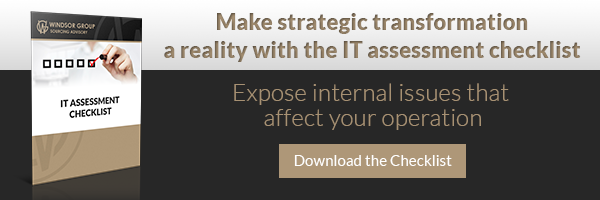.jpg) Who needs a formal checklist? Your key IT staff have been with your company for years. They know your systems like the backs of their hands, right? Well, in the unlikely event that is actually 100% true, an IT infrastructure assessment checklist can still serve as a fail-safe.
Who needs a formal checklist? Your key IT staff have been with your company for years. They know your systems like the backs of their hands, right? Well, in the unlikely event that is actually 100% true, an IT infrastructure assessment checklist can still serve as a fail-safe.
And for all of you who are pretty sure your people do not have a complete, off-the-cuff command of every IT detail, here are some reasons you should seriously consider creating that IT infrastructure assessment checklist, no matter what.
-
You won’t overlook anything when you’re conducting a review. You do regularly review your IT program, don’t you?
-
New people who have joined your organization don’t have the same “history” as long-term employees to fall back on, which is only one reason documentation is important. Allowing your personnel to keep important knowledge, and even the resulting insight, in their head isn’t a good idea, because you can’t benefit fully from it.
-
Consistency, another reason documentation is so important. Tracking your enterprise-wide IT needs and usage over time enables you to plot trends. You can readily identify areas that require remediation and opportunities to expand or improve service and quality. Using an IT infrastructure assessment checklist helps gather valuable data for planning and analysis.
-
Things change internally. Aside from new hires, it’s easy to forget that you’ve added or eliminated hardware or software or instituted procedural changes that can have broad ramifications throughout your organization.
-
You can avoid decisions based on assumptions. You always know where you stand without having to hazard a “best guess,” which is often not all that accurate. Your competition is busy sharpening their edge, so you can’t remain competitive yourself without the ability to make equally sharp, strategic decisions.
-
You can see every dollar, to ensure your IT investment is generating the company-wide returns that you expect and need.
-
You can accurately evaluate opportunity costs associated with obtaining and implementing new technologies. Is it time for transformative change? If so, in what direction(s) and how much? Along with well-targeted strategic planning, you need to ensure your IT systems remain ahead of the curve, to strengthen long-term business capacity and remain agile.
-
Things change externally. Customers, and employees, too, are using more mobile devices from more access points. Who knows what’s on the horizon? An IT infrastructure assessment checklist helps you keep tabs on your ability to comfortably integrate the newest technologies and services that are in high demand. Failure to step up to environmental change can cause widespread corporate dysfunction.
-
What’s on your corporate drawing board? Your checklist will help you quickly determine if you have the systems in place to move forward with new product development, market expansion or other initiatives that require specific capabilities or extended agility and scalability.
-
You can ensure IT continues to be closely aligned with long term corporate goals, because that’s the only way to achieve growth and increased profitability. Alignment requires continuous improvement to ensure computing and communications systems are well-synchronized.
-
Armed with detailed information, you can uncover ways to save money, with greater efficiencies, better integration, lower labor and overhead costs, especially for power consumption and physical facilities. By optimizing spending and cutting capital funding requirements, you can be more strategic about investing precious corporate resources.
-
Your IT infrastructure assessment checklist can help you meet corporate goals for increasing sustainability.
Creating and using an IT infrastructure assessment checklist ensures that your business review process is comprehensive, not just an inventory update. With your checklist in hand, it’s far easier to understand where you are right now, compared to where you want to be in the future. And that’s the foundation of successful business development.


